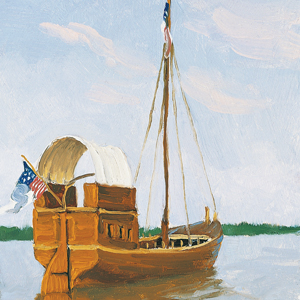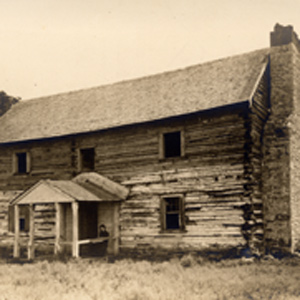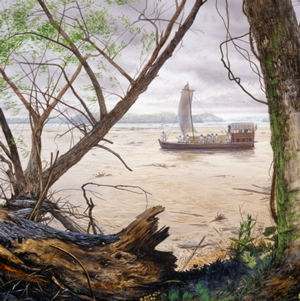Thomas Rodney, Revolutionary War soldier, was journeying to Washington, the capital of the Mississippi Territory. In July 1803, Thomas Jefferson had appointed him as territorial judge and also as a land commissioner.[1]Dwight L. Smith and Ray Swick, ed., A Journey Through the West: Thomas Rodney’s 1803 Journal from Delaware to the Mississippi Territory (Athens: Ohio University Press, 1997), 8. Rodney’s journals show that he considered himself somewhat of a gentleman’s scientist in line with the contemporary Age of Enlightenment. Although he wasn’t the caliber of Meriwether Lewis, Rodney documented many of the natural curiosities that would have also piqued Lewis’s interest traveling down the Ohio River in 1803.
Contemporary traveler Thomas Rodney arrived at the Big Bone Lick just days after Lewis had left. Rodney seems almost miffed that Lewis got the best specimens.[2]Ibid., 111–112.
After departing Big Bone Lick, Rodney examined the fossils he had collected there. He speculated that they may be not be the actual bones of animals, but nature’s recreation, and exaggeration, of decomposed animals. Lewis likely made his own speculations as he traveled between Big Bone Lick and the Falls of the Ohio that October.
Because Lewis wrote so little during the Ohio segment and Rodney wrote so much, selections from Rodney’s journal are used to describe the journey from 7 October 1803 to 11 November 1803. The pages below are the days when Lewis and Rodney were physically together.
September 7, 1803
Wheeling, (West) Virginia


Wheeling, WV At this common port of departure for Ohio River boats, Lewis receives the cargo that had come by wagon over the Braddock Road. He finds it is in good order and in the evening, he meets with Thomas Rodney.
September 8, 1803
Buying another pirogue


Wheeling, WV Lewis re-supplies and gives the crew a day to rest. He writes a letter to President Thomas Jefferson, purchases another pirogue, and meets with Doctor William Patterson who offers to join. He dines, and later has dessert, with Thomas Rodney.
September 9, 1803
Leaving Wheeling


Below Wheeling, WV When Dr. Patterson fails to appear by 3pm, so Lewis decides to head down the Ohio without him. Fellow river traveler Thomas Rodney is there to say goodbye. During the night, it rains so hard that Lewis is unable to keep the cargo dry.
September 12, 1803
Cutting a channel


Belmont, WV To pass through a shallow spot in the Long Reach of the Ohio River, the men must cut a channel through the gravel. They anchor about nine miles upstream from Marietta, Ohio. Three days behind, Thomas Rodney reaches Wheeling.
October 17, 1803
Wine with Col. Rodney


Falls of the Ohio, KY-IN Clark and Lewis visit fellow traveler Thomas Rodney sharing wine on his bateaux moored at Bear Grass Creek. In Washington City, Thomas Jefferson gives his third Annual Message to Congress.
December 2, 1803
Kaskaskia observations


Fort Kaskaskia, IL Lewis takes celestial observations using the stars Polaris, Alderbaran and Regulas. Thomas Rodney, who had traveled down the Ohio at the same time as Lewis, reports his arrival at the Mississippi Territory.
May 14, 1804
Leaving Camp River Dubois


Clark and most of the men leave winter camp at the River Dubois and begin their journey up the Missouri. Several enlisted men begin their journals while in St. Louis, Lewis makes final preparations.
